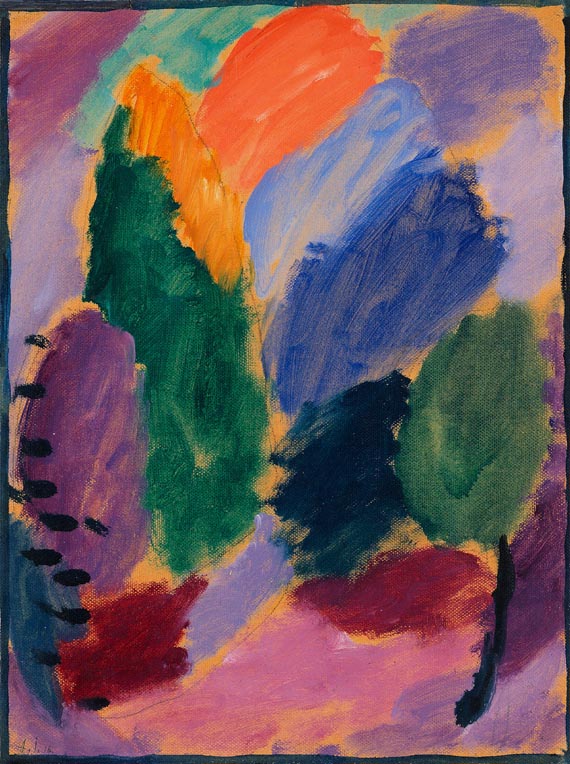
24
Alexej von Jawlensky
Variation, 1915.
Oil
Estimate:
€ 100,000 / $ 107,000 Sold:
€ 152,500 / $ 163,175 (incl. surcharge)
Oil over pencil on paper with canvas embossing, laid on cardboard
Jawlensky/Pieroni-Jawlensky 674. Monogrammed and dated lower left. Signed under an erased dedication on verso of backing cardboard, also dated and inscribed " N.7" and "St. Prex". 36,4 x 27,1 cm (14,3 x 10,6 in)Measurements of backing cardboard: 50,3 x 40,3 cm (19,8 x 15,9 in).
PROVENANCE: Private collection southern Germany.
Jawlensky only began his artistic training in 1889 in St. Petersburg after a career as an officer in the tsarist army. He studied under Ilja Repin who introduced him to Marianne von Werefkin and Helene Nesnakomoff, his later wife. Jawlensky accompanied these two to Munich in 1896 where they wanted to visit a private art school. Here Jawlensky met Wassily Kandinsky. The artist undertook several trips to France and was able to show ten paintings at the 1905 'Salon d'automne' with the help of Sergej Djagilev. Jawlensky also met Henri Matisse for the first time. In summer 1908 he worked with Kandinsky, Marianne von Werefkin and Gabriele Münter in Murnau for the first time. There the four artists developed the idea for the foundation of the 'Neue Künstlervereinigung München' (‘Munich New Artists' Association‘) to which they aligned with other artists. In December the first exhibition took place in Munich. Two years later the 'Blauer Reiter' was established as a new idea of co-operation. In 1913 Jawlensky participated in Herwarth Walden's first German autumn Salon in Berlin. When World War I began in 1914 Jawlensky was expelled from Germany due to his Russian citizenship. He moved with his family and Marianne von Werefkin to Prex on Lake Geneva.
In his serial works Jawlensky achieved a perfection of one and the same motif from different emotional perspectives like no other of his contemporaries. The large amount of ‘Meditations‘ is just one proof thereof. With the 'Variations‘ the name says it all. Jawlensky is borne by the inspirations of the colors, which he attributed to a composition of amorphic forms, definitely not without the influence of Kandinsky, with whom he worked closely together in his days in Munich. The often evoked relation between music in abstract art seems to have found a strong manifestation in these works, as the basic theme remains the same.
In Switzerland, where he began painting his abstract heads in 1918, he remained until 1921, followed by his final move to Wiesbaden in 1921. An attack of arthritis in 1929 forced the artist to visit various spas at regular intervals. Jawlensky suffered from a progressing paralysis and had difficulties in painting. In 1933 the National Socialists imposed an occupational ban on him. One year later the painter began the series of small-format 'Meditations'. 72 of his works were confiscated in 1937 as "degenerate". Four years later in 1941 Jawlensky died in Wiesbaden. [KD].
24
Alexej von Jawlensky
Variation, 1915.
Oil
Estimate:
€ 100,000 / $ 107,000 Sold:
€ 152,500 / $ 163,175 (incl. surcharge)




 Lot 24
Lot 24 